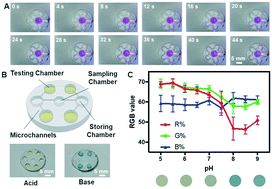Microengineered poly(HEMA) hydrogels for wearable contact lens biosensing†
Abstract
Microchannels in hydrogels play an essential role in enabling a smart contact lens. However, microchannels have rarely been created in commercial hydrogel contact lenses due to their sensitivity to conventional microfabrication techniques. Here, we report the fabrication of microchannels in poly(2-hydroxyethyl methacrylate) (poly(HEMA)) hydrogels that are used in commercial contact lenses with a three-dimensional (3D) printed mold. We investigated the corresponding capillary flow behaviors in these microchannels. We observed different capillary flow regimes in these microchannels, depending on their hydration level. In particular, we found that a peristaltic pressure could reinstate flow in a dehydrated channel, indicating that the motion of eye-blinking may help tears flow in a microchannel-containing contact lens. Colorimetric pH and electrochemical Na+ sensing capabilities were demonstrated in these microchannels. This work paves the way for the development of microengineered poly(HEMA) hydrogels for various biomedical applications such as eye-care and wearable biosensing.



 Please wait while we load your content...
Please wait while we load your content...